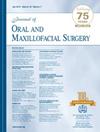Does Combining Arthrocentesis With Injectable Platelet-Rich Fibrin Outperform Arthrocentesis or Injectable Platelet-Rich Fibrin Alone in Alleviating Pain and Improving Function in Temporomandibular Joint Dysfunction?
IF 2.3
3区 医学
Q2 DENTISTRY, ORAL SURGERY & MEDICINE
引用次数: 0
Abstract
Background
Arthrocentesis (AC), with/without intra-articular agents like hyaluronic acid, steroids, platelet-rich plasma, and platelet-rich fibrin, is used with varying effectiveness to manage temporomandibular joint (TMJ) intra-articular pain and dysfunction (IPD).
Purpose
The purpose of this study was to measure changes in pain, range of motion, and quality of life (QOL) in subjects with IPD who underwent AC/injectable platelet-rich fibrin (i-PRF)/AC + i-PRF injection.
Study design, setting and sample: A single-centre randomized clinical trial was conducted at All India Institute of Medical Sciences, Rishikesh, on patients with unilateral IPD (Wilkes II, III, and IV) confirmed by magnetic resonance imaging. Exclusion criteria included age below 18/above 50 years, autoimmune diseases, magnetic resonance imaging contraindications, previous TMJ surgery, congenital/developmental TMJ disorders, and TMJ lesions.
Predictor variable
Predictor variables were treatment modalities (AC/i-PRF/AC + i-PRF) assigned using computer generated randomization.
Main outcome variable
The primary outcome was TMJ pain at 3 months measured with visual analog scale. Secondary outcomes included range of motion, muscle tenderness, and QOL. Data was collected preoperatively (T0) and postoperatively at 10 days (T1), 1 month (T2), and 3 months (T3) by a blinded observer.
Covariates
Covariates included age, sex, and involved joint (right/left) and Wilkes staging.
Analyses
Repeated measure analysis of variance with post hoc analysis was used (P < .05).
Results
The study included 48 patients with mean ages of 29.9 ± 7.8 years (AC), 36.5 ± 10.9 years (i-PRF), and 27.2 ± 8.5 years (AC + i-PRF) (P = .019), with a higher female prevalence: 68.8% in AC and i-PRF, and 87.5% in AC + i-PRF (P = .4). TMJ pain significantly reduced at T3 in AC + i-PRF compared to AC (mean difference[MD]: 2.1, 95% confidence interval [CI]: 3.3 to 0.9; P < .01) and i-PRF (MD: 1.5, 95% CI: 2.7 to 0.3; P = .012).AC + i-PRF also showed significant improvement in mouth opening (MD: 3.9, 95% CI: 1.1 to 6.8; P = .005) and QOL compared to AC (MD: −4.3, 95% CI: −7.7 to −0.9; P = .009) and i-PRF (MD: −3.6, 95% CI: −6.9 to −0.2; P = .03).
Conclusion
AC + i-PRF outperforms AC/i-PRF alone in improving pain, range of motion and overall QOL in Wilkes II, III, and IV, making it a promising treatment option for TMJ IPD.
关节穿刺联合注射富血小板纤维蛋白在减轻颞下颌关节功能障碍的疼痛和改善功能方面是否优于关节穿刺或单独注射富血小板纤维蛋白?
背景:关节穿刺(AC),联合/不联合关节内药物,如透明质酸、类固醇、富血小板血浆和富血小板纤维蛋白,用于治疗颞下颌关节(TMJ)关节内疼痛和功能障碍(IPD),效果不同。目的:本研究的目的是测量IPD患者接受AC/可注射富血小板纤维蛋白(i-PRF)/AC + i-PRF注射后疼痛、活动范围和生活质量(QOL)的变化。研究设计、环境和样本:在全印度医学科学研究所进行了一项单中心随机临床试验,研究对象是经磁共振成像证实的单侧IPD (Wilkes II、III和IV)患者。排除标准包括年龄18岁以下/ 50岁以上、自身免疫性疾病、磁共振成像禁忌症、既往TMJ手术、先天性/发育性TMJ疾病和TMJ病变。预测变量:预测变量是使用计算机随机化分配的治疗方式(AC/i-PRF/AC + i-PRF)。主要结局变量:主要结局是3个月时用视觉模拟量表测量TMJ疼痛。次要结果包括活动范围、肌肉压痛和生活质量。术前(T0)、术后10天(T1)、1个月(T2)和3个月(T3)由盲法观察者收集数据。协变量:协变量包括年龄、性别、受累关节(右/左)和Wilkes分期。结果:研究纳入48例患者,平均年龄为29.9±7.8岁(AC)、36.5±10.9岁(i-PRF)和27.2±8.5岁(AC + i-PRF) (P = 0.019),女性患病率较高:AC + i-PRF为68.8%,AC + i-PRF为87.5% (P = 0.4)。与AC相比,AC + i-PRF组T3时TMJ疼痛显著减轻(平均差[MD]: 2.1, 95%可信区间[CI]: 3.3至0.9;结论:AC + i-PRF在改善Wilkes II, III和IV期患者的疼痛,活动范围和总体生活质量方面优于AC/i-PRF,使其成为TMJ IPD的有希望的治疗选择。
本文章由计算机程序翻译,如有差异,请以英文原文为准。
求助全文
约1分钟内获得全文
求助全文
来源期刊

Journal of Oral and Maxillofacial Surgery
医学-牙科与口腔外科
CiteScore
4.00
自引率
5.30%
发文量
0
审稿时长
41 days
期刊介绍:
This monthly journal offers comprehensive coverage of new techniques, important developments and innovative ideas in oral and maxillofacial surgery. Practice-applicable articles help develop the methods used to handle dentoalveolar surgery, facial injuries and deformities, TMJ disorders, oral cancer, jaw reconstruction, anesthesia and analgesia. The journal also includes specifics on new instruments and diagnostic equipment and modern therapeutic drugs and devices. Journal of Oral and Maxillofacial Surgery is recommended for first or priority subscription by the Dental Section of the Medical Library Association.
 求助内容:
求助内容: 应助结果提醒方式:
应助结果提醒方式:


